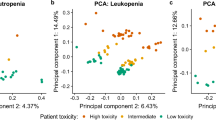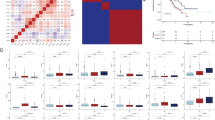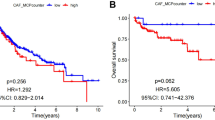Abstract
Purpose
Crizotinib is the first-line small molecule tyrosine kinase inhibitor for ALK-positive non-small cell lung cancer. In this study, a retrospective pharmacogenomics investigation was conducted to explore the relationship between genes related to RTK downstream signaling pathways and crizotinib-induced hepatic toxicity in ALK-positive NSCLC patients.
Methods
The variable importance analysis of random forest algorithm was applied to identify the significant features which contribute to the crizotinib sensitivity in Cancer Cell Line Encyclopedia (CCLE) database. The KEGG and reactome pathway enrichment analysis were conducted with EnrichR. The differential expression genes were identified with R package DESeq2 in CCLE liver derived cell lines between crizotinib sensitive and resistant groups. From 2012 to 2015, 42 NSCLC patients were enrolled in this study. 90 polymorphisms were genotyped using the Sequenom Massarray system. Sequencing of HGFR (c-Met) genes was carried out on the Ion Torrent Proton.
Results
In total, 66.7% NSCLC patients suffered from crizotinib-induced liver toxicity and 11.9% progressed to severe hepatic toxicity. The features with the top importance from classification and regression random forest model were enriched in RTK downstream signaling pathways (JAK/STAT, RAS/RAF/MAPK, PI3K/AKT pathways) and immune system-related pathways. Collagen family genes (COL1A1, COL1A2, COL6A1, COL5A1) and other extracellular matrix protein (TNC, TAGLN, TENM2, EDIL3, VCAN, CNN1, SH3BP4, TAGLN), which were closely related to MAPK-ERK signaling pathways, were significantly enriched in crizotinib resistant cell lines. In multiple logistic regression, STAT1 rs10208033 (T > C) was significantly associated with crizotinib-induced liver toxicity (OR = 6.733, 95% CI 1.406–32.24, P = 0.017). Compared with non-CC, OR is 5.5 (95% CI 1.219–24.81, P = 0.027) for STAT1 rs10208033 CC genotype to develop crizotinib-induced liver toxicity. Further cell viability test in human fetal hepatocyte line, L-02, reveals that the STAT1 inhibitor might protect hepatocyte cells from the toxicity caused by crizotinib.
Conclusion
Polymorphism of rs10208033 is a potential biomarker for predicting crizotinib-induced hepatotoxicity. These results suggest that STAT1 plays an important role in crizotinib-induced hepatotoxicity. Further studies are needed to confirm our finding and understand the underlying mechanisms.





Similar content being viewed by others
Data availability
The Cancer Cell Line encyclopedia (CCLE) RNAseq gene expression data (RPKM) and the pharmacologic profile for 24 anticancer drugs across 504 (24 Feb 2015) were downloaded from http://portals.broadinstitute.org/ccle. In this work, those who carried out the original analysis and collection of the CCLE Data bear no responsibility for the further analysis or interpretation of it. The datasets generated and/or analyzed during the current clinical cohort are not publicly available due to the China Human Genetic Resources Regulations, but are available from the corresponding author on reasonable email request.
References
Auton A, Brooks LD, Durbin RM, Garrison EP, Kang HM, Korbel JO, Marchini JL, McCarthy S, McVean GA, Abecasis GR (2015) A global reference for human genetic variation. Nature 526:68–74
Chalupsky K, Kanchev I, Zbodakova O, Buryova H, Jirouskova M, Korinek V, Gregor M, Sedlacek R (2013) ADAM10/17-dependent release of soluble c-Met correlates with hepatocellular damage. Folia Biol (Praha) 59:76–86
Chang Y, Park H, Yang HJ, Lee S, Lee KY, Kim TS, Jung J, Shin JM (2018) Cancer drug response profile scan (CDRscan): a deep learning model that predicts drug effectiveness from cancer genomic signature. Sci Rep 8:8857
Chen EY, Tan CM, Kou Y, Duan Q, Wang Z, Meirelles GV, Clark NR, Ma’Ayan A (2013) Enrichr: interactive and collaborative HTML5 gene list enrichment analysis tool. BMC Bioinform 14:128
Haider S, Rahman R, Ghosh S, Pal R (2015) A Copula based approach for design of multivariate random forests for drug sensitivity prediction. PLoS ONE 10:e0144490
Heintzman ND, Stuart RK, Hon G, Fu Y, Ching CW, Hawkins RD, Barrera LO, Van Calcar S, Qu C, Ching KA, Wang W, Weng Z, Green RD, Crawford GE, Ren B (2007) Distinct and predictive chromatin signatures of transcriptional promoters and enhancers in the human genome. Nat Genet 39:311–318
Iorio F, Knijnenburg TA, Vis DJ, Bignell GR, Menden MP, Schubert M, Aben N, Goncalves E, Barthorpe S, Lightfoot H, Cokelaer T, Greninger P, van Dyk E, Chang H, de Silva H, Heyn H, Deng X, Egan RK, Liu Q, Mironenko T, Mitropoulos X, Richardson L, Wang J, Zhang T, Moran S, Sayols S, Soleimani M, Tamborero D, Lopez-Bigas N, Ross-Macdonald P, Esteller M, Gray NS, Haber DA, Stratton MR, Benes CH, Wessels L, Saez-Rodriguez J, McDermott U, Garnett MJ (2016) A landscape of pharmacogenomic interactions in cancer. Cell 166:740–754
Jung D, Han JM, Yee J, Kim JY, Gwak HS (2018) Factors affecting crizotinib-induced hepatotoxicity in non-small cell lung cancer patients. Med Oncol 35:154
Kassem L, Shohdy KS, Lasheen S, Abdel-Rahman O, Ali A, Abdel-Malek RR (2019) Safety issues with the ALK inhibitors in the treatment of NSCLC: a systematic review. Crit Rev Oncol Hematol 134:56–64
Kazandjian D, Blumenthal GM, Chen HY, He K, Patel M, Justice R, Keegan P, Pazdur R (2014) FDA approval summary: crizotinib for the treatment of metastatic non-small cell lung cancer with anaplastic lymphoma kinase rearrangements. Oncologist 19:e5-11
Kim WH, Hong F, Radaeva S, Jaruga B, Fan S, Gao B (2003) STAT1 plays an essential role in LPS/D-galactosamine-induced liver apoptosis and injury. Am J Physiol Gastrointest Liver Physiol 285:G761–G768
Kuleshov MV, Jones MR, Rouillard AD, Fernandez NF, Duan Q, Wang Z, Koplev S, Jenkins SL, Jagodnik KM, Lachmann A, McDermott MG, Monteiro CD, Gundersen GW, Ma’Ayan A (2016) Enrichr: a comprehensive gene set enrichment analysis web server 2016 update. Nucleic Acids Res 44:W90–W97
Liu B, Yuan M, Sun Y, Cheng Z, Zhang Z, Hou S, Wang X, Liu J (2018) Incidence and risk of hepatic toxicities associated with anaplastic lymphoma kinase inhibitors in the treatment of non-small-cell lung cancer: a systematic review and meta-analysis. Oncotarget 9:9480–9488
Marti-Rodrigo A, Alegre F, Moragrega AB, Garcia-Garcia F, Marti-Rodrigo P, Fernandez-Iglesias A, Gracia-Sancho J, Apostolova N, Esplugues JV, Blas-Garcia A (2019) Rilpivirine attenuates liver fibrosis through selective STAT1-mediated apoptosis in hepatic stellate cells. Gut 69:920
Menden MP, Iorio F, Garnett M, McDermott U, Benes CH, Ballester PJ, Saez-Rodriguez J (2013) Machine learning prediction of cancer cell sensitivity to drugs based on genomic and chemical properties. PLoS ONE 8:e61318
Sato Y, Fujimoto D, Shibata Y, Seo R, Suginoshita Y, Imai Y, Tomii K (2014) Fulminant hepatitis following crizotinib administration for ALK-positive non-small-cell lung carcinoma. Jpn J Clin Oncol 44:872–875
Shaw AT, Kim DW, Nakagawa K, Seto T, Crino L, Ahn MJ, De Pas T, Besse B, Solomon BJ, Blackhall F, Wu YL, Thomas M, O’Byrne KJ, Moro-Sibilot D, Camidge DR, Mok T, Hirsh V, Riely GJ, Iyer S, Tassell V, Polli A, Wilner KD, Janne PA (2013) Crizotinib versus chemotherapy in advanced ALK-positive lung cancer. N Engl J Med 368:2385–2394
Smith E, Shilatifard A (2014) Enhancer biology and enhanceropathies. Nat Struct Mol Biol 21:210–219
Soda M, Choi YL, Enomoto M, Takada S, Yamashita Y, Ishikawa S, Fujiwara S, Watanabe H, Kurashina K, Hatanaka H, Bando M, Ohno S, Ishikawa Y, Aburatani H, Niki T, Sohara Y, Sugiyama Y, Mano H (2007) Identification of the transforming EML4-ALK fusion gene in non-small-cell lung cancer. Nature 448:561–566
Solomon BJ, Mok T, Kim DW, Wu YL, Nakagawa K, Mekhail T, Felip E, Cappuzzo F, Paolini J, Usari T, Iyer S, Reisman A, Wilner KD, Tursi J, Blackhall F (2014) First-line crizotinib versus chemotherapy in ALK-positive lung cancer. N Engl J Med 371:2167–2177
Trynka G, Westra HJ, Slowikowski K, Hu X, Xu H, Stranger BE, Klein RJ, Han B, Raychaudhuri S (2015) Disentangling the effects of colocalizing genomic annotations to functionally prioritize non-coding variants within complex-trait loci. Am J Hum Genet 97:139–152
van Geel RM, Hendrikx JJ, Vahl JE, van Leerdam ME, van den Broek D, Huitema AD, Beijnen JH, Schellens JH, Burgers SA (2016) Crizotinib-induced fatal fulminant liver failure. Lung Cancer 93:17–19
Yang Y, Wu XQ, Li WX, Huang HM, Li HD, Pan XY, Li XF, Huang C, Meng XM, Zhang L, Lv XW, Wang H, Li J (2018) PSTPIP2 connects DNA methylation to macrophage polarization in CCL4-induced mouse model of hepatic fibrosis. Oncogene 37:6119–6135
Yuan H, Paskov I, Paskov H, Gonzalez AJ, Leslie CS (2016) Multitask learning improves prediction of cancer drug sensitivity. Sci Rep 6:31619
Zentner GE, Tesar PJ, Scacheri PC (2011) Epigenetic signatures distinguish multiple classes of enhancers with distinct cellular functions. Genome Res 21:1273–1283
Zhang H, Chen F, Fan X, Lin C, Hao Y, Wei H, Lin W, Jiang Y, He F (2017) Quantitative proteomic analysis on activated hepatic stellate cells reversion reveal STAT1 as a key regulator between liver fibrosis and recovery. Sci Rep 7:44910
Zhang Y, Xu YY, Chen Y, Li JN, Wang Y (2019) Crizotinib-induced acute fatal liver failure in an Asian ALK -positive lung adenocarcinoma patient with liver metastasis: a case report. World J Clin Cases 7:1080–1086
Zhou X, Maricque B, Xie M, Li D, Sundaram V, Martin EA, Koebbe BC, Nielsen C, Hirst M, Farnham P, Kuhn RM, Zhu J, Smirnov I, Kent WJ, Haussler D, Madden PA, Costello JF, Wang T (2011) The human epigenome browser at Washington University. Nat Methods 8:989–990
Funding
This work was supported by the National Nature Science Foundation of China (No. 81572270, 81730103, 81473283, 81973398); and the Natural Major Projects for Science and Technology Development from Science and Technology Ministry of China (No.2012ZX09506001-004), and the National Key Research and Development Program (No. 2016YFC0905001) and the 111 project (No.B16047).
Author information
Authors and Affiliations
Contributions
SX, XDW, LKC, and MH, conceived and planned the experiments. WFF, JWL, and ZW carried out the experiments. JWL and CZW planned and carried out the data analysis. DLL and WFF contributed to sample preparation and clinical data collection. QFH contributed to the interpretation of the results. SX took the lead in writing the manuscript and the results. All authors provided critical feedback and helped shape the research, analysis and manuscript.
Corresponding authors
Ethics declarations
Conflict of interest
The authors have declared no conflicts of interest.
Ethical approval
The study was approved by the Ethical Committee of Sun Yat-Sen University Cancer Center (B2015-080-01).
Informed consent
Written informed consent was obtained from all participating subjects. This trial was registered at ClinicalTrials.gov. (NCT02708667).
Additional information
Publisher's Note
Springer Nature remains neutral with regard to jurisdictional claims in published maps and institutional affiliations.
Electronic supplementary material
Below is the link to the electronic supplementary material.
432_2020_3476_MOESM1_ESM.tiff
Supplementary Figure1: The epigenomic landscape of SNP rs10208033 in adult liver cells visualized by the Human Epigenome Browser (TIFF 739 KB)
432_2020_3476_MOESM2_ESM.tif
Supplementary Figure 2: Agarose gel electrophoresis was adopted to detect the STAT1 gene expression under different crizotinib concentration (TIF 396 KB)
432_2020_3476_MOESM4_ESM.xlsx
Supplementary Table 2. IncNode Purity for each feature in the regression and classification Random Forest models (XLSX 70 KB)
432_2020_3476_MOESM6_ESM.docx
Supplementary Table 4. The result of RNA differential expression genes by DESeq2. Table 5. The association between genetic polymorphisms and crizotinib-induced Grade≥2 severe hepatic toxicity by multivariate logsitic regression. Table 6. The correlation between genetic polymorphisms and crizotinib-induced elevations of ALT. Table 7. The Locus Score of rs10208033 analysed from Goshifter (DOCX 52 KB)
Rights and permissions
About this article
Cite this article
Xin, S., Fang, W., Li, J. et al. Impact of STAT1 polymorphisms on crizotinib-induced hepatotoxicity in ALK-positive non-small cell lung cancer patients. J Cancer Res Clin Oncol 147, 725–737 (2021). https://doi.org/10.1007/s00432-020-03476-4
Received:
Accepted:
Published:
Issue Date:
DOI: https://doi.org/10.1007/s00432-020-03476-4




